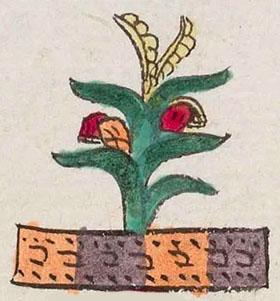chinamitl (Mdz46r)
This element has been carved from the compound sign for the place name, Chinantlan. We have left the maize plant, although the chinamitl (agricultural parcel, or chinampa in contemporary Mexican Spanish), could appear without the plant. Here the chinamitl has purple and orange-colored segmentation, much like the milli and often the tlalli, other names for agricultural parcels. The green-leafy maize plant is both flowering and has produced maize or corn cobs of different colors. The flowers are yellow. Interestingly, the parcel is seen from a bird's eye view, but the maize plant is shown as an elevation view.
Stephanie Wood
The chinamitl was often associated with the agricultural parcels carved from the lake islands and littoral, what people call "floating gardens," but they were not really floating. The dots and u's seem to suggest agricultural activity; perhaps it is meant to appear as a parcel that has been planted. The u's look something like horseshoe prints, but this iconography reaches back on stone carvings into pre-contact times, before the horse was reintroduced in Mesoamerica. The chinamitl, as represented here, does not differ greatly from the appearance of the tlalli or the milli, both of which were also agricultural parcels, often segmented and multi-colored. Milli entered Spanish as milpa. But a glyph for chinamitl, below, also shows how the emphasis can be placed on the construction that held the mud pulled up from the lake bottom to enrich agricultural parcels.
Stephanie Wood
c. 1541, but by 1553 at the latest
Stephanie Wood
maize, maíz, corn, agricultura, chinampas
The rectangle on the lower edge of this image from plate 20 of the Codex Borgia (pre-contact) shows what is an agricultural piece of land, given the maize plants growing up from it. Like the Codex Mendoza tlalli, milli, and chinamitl iconography, this one is separated into what may be parcels with alternating terracotta and dark gray coloration. What is different about each possible parcel are the lines for what may be furrows that alternate perpendicularly from the next one. This is similar to the chinampas that alternate in the map from San Pedro Tlahuac in our Mapas Project. Elizabeth Hill Boone has also noted this alternation in chinampas in Painted Words: Nahua Catholicism, Politics, and Memory in the Atzaqualco Pictorial Catechism, Boone, Burkhart, and Tavárez eds., Washington DC: Dumbarton Oaks, 2017, 48 and 72. Codex Borgia image thanks to Mexicolore. Also, thanks to James Maffie for bringing these comparisons to the fore (personal communication 13 March 2025).

chinampa
Mexico City
Stephanie Wood
Codex Mendoza, folio 46 recto, https://digital.bodleian.ox.ac.uk/objects/2fea788e-2aa2-4f08-b6d9-648c00..., image 102 of 188.
The Bodleian Libraries, University of Oxford, hold the original manuscript, the MS. Arch. Selden. A. 1. This image is published here under the UK Creative Commons, “Attribution-NonCommercial-ShareAlike 3.0 License” (CC-BY-NC-SA 3.0).




